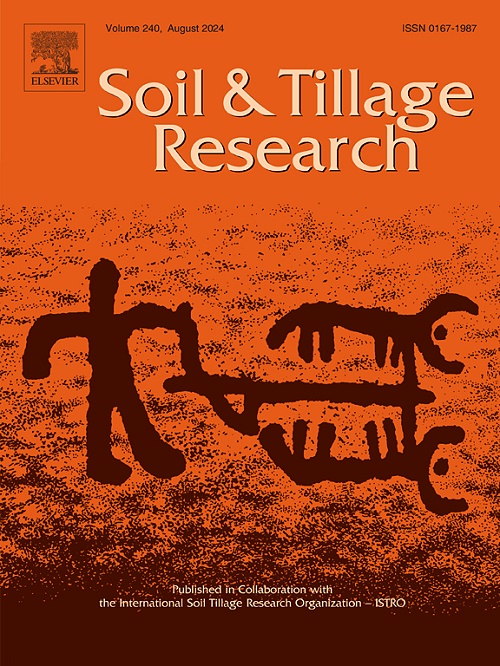Sustainable no–tillage practices with a disc type novel residue cleaning mechanism: Design, development and field evaluation
IF 6.1
1区 农林科学
Q1 SOIL SCIENCE
引用次数: 0
Abstract
Crop residue management in no–tillage under conservation agriculture is crucial for maintaining soil health and optimizing crop yields. This study presents a residue cleaning mechanism specially designed for no–tillage sowing to overcome challenges posed by crop residues left by combine harvesters. This research involved design, development and field–evaluation of a residue cleaning unit attached to a seed–cum–fertilizer drill equipped with a broad–spacing toolbar. The initial trials optimized operational parameters in a test soil bin, showing maximum residue removal efficiency at 45° disc angle and 20° tilt angle. Following these trials, a tractor drawn six units of residue cleaning discs, each with 12 teeth and a diameter of 350 mm were fabricated along with an inverted T–type furrow opener. The developed prototype of six-row seed–cum–fertilizer drill with a residue cleaning mechanism (T1) was evaluated for the wheat–green gram–maize cropping system and compared with the ten–row Happy Seeder (T2). The results showed that the improvement in grain yield for green gram (6.05 %) was significantly higher for T1 compared to T2. However, the improvements in grain yield for wheat (4.43 %) and maize (0.86 %) was not statistically significant (p < 0.05), resulting in higher net incomes for T1. For each cropping system, the energy analysis showed that, T1 (27.47 MJ/kg) required slightly less specific energy than T2 (28.34 MJ/kg). However, T1 had slightly higher total carbon emissions (10970.89 kg CO2eq/ha) compared to T2 (10638.17 kg CO2eq/ha). The benefit–cost ratio was lower for T1 (2.08) compared to T2 (2.16), but increasing the number of rows in the T1 treatment could enhance field capacity, potentially reducing carbon emissions and improving economic returns.
圆盘式新型残留物清理机制的可持续免耕实践:设计、开发和田间评价
保护性农业免耕作物残茬管理对保持土壤健康、优化作物产量具有重要意义。本研究提出了一种专门为免耕播种设计的残茬清理机制,以克服联合收割机留下的作物残茬带来的挑战。这项研究包括设计、开发和现场评估一种附着在带有宽间距工具栏的种子兼肥料钻机上的残留物清理装置。最初的试验优化了试验土仓的操作参数,在45°圆盘角和20°倾斜角下,残渣去除效率最高。在这些试验之后,一台拖拉机牵引了6个残渣清理圆盘,每个圆盘有12个齿,直径为350 mm,与一个倒t型开沟器一起制作。对研制的六行除残播种机(T1)在小麦-绿克-玉米种植系统中的应用进行了评价,并与十行快乐播种机(T2)进行了比较。结果表明,与T2相比,T1处理对绿克籽粒产量的提高(6.05 %)显著高于T2处理。然而,小麦(4.43 %)和玉米(0.86 %)产量的提高没有统计学意义(p <; 0.05),导致T1的纯收入增加。能量分析表明,T1 (27.47 MJ/kg)比能略低于T2 (28.34 MJ/kg)。然而,T1的总碳排放量(10970.89 kg CO2eq/ha)略高于T2(10638.17 kg CO2eq/ha)。与T2(2.16)相比,T1(2.08)处理的效益成本比较低,但增加T1处理的行数可以提高田间产能,潜在地减少碳排放并提高经济回报。
本文章由计算机程序翻译,如有差异,请以英文原文为准。
求助全文
约1分钟内获得全文
求助全文
来源期刊

Soil & Tillage Research
农林科学-土壤科学
CiteScore
13.00
自引率
6.20%
发文量
266
审稿时长
5 months
期刊介绍:
Soil & Tillage Research examines the physical, chemical and biological changes in the soil caused by tillage and field traffic. Manuscripts will be considered on aspects of soil science, physics, technology, mechanization and applied engineering for a sustainable balance among productivity, environmental quality and profitability. The following are examples of suitable topics within the scope of the journal of Soil and Tillage Research:
The agricultural and biosystems engineering associated with tillage (including no-tillage, reduced-tillage and direct drilling), irrigation and drainage, crops and crop rotations, fertilization, rehabilitation of mine spoils and processes used to modify soils. Soil change effects on establishment and yield of crops, growth of plants and roots, structure and erosion of soil, cycling of carbon and nutrients, greenhouse gas emissions, leaching, runoff and other processes that affect environmental quality. Characterization or modeling of tillage and field traffic responses, soil, climate, or topographic effects, soil deformation processes, tillage tools, traction devices, energy requirements, economics, surface and subsurface water quality effects, tillage effects on weed, pest and disease control, and their interactions.
 求助内容:
求助内容: 应助结果提醒方式:
应助结果提醒方式:


